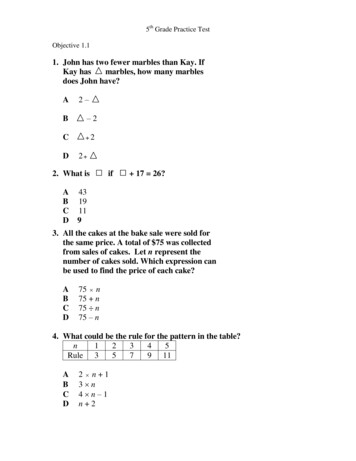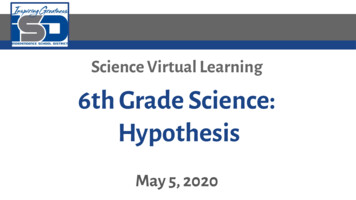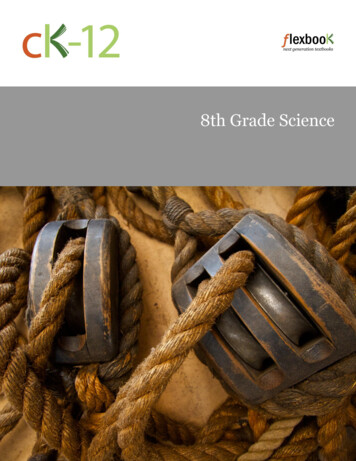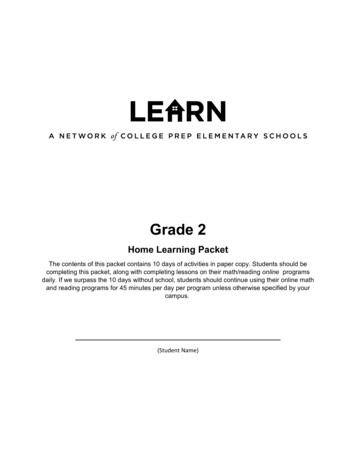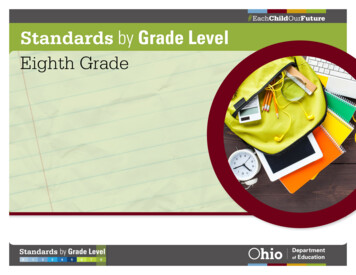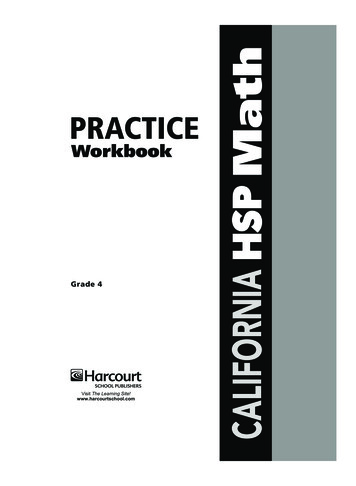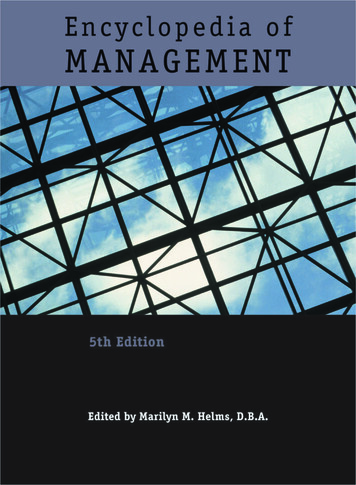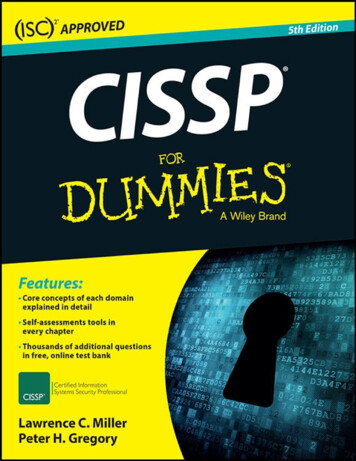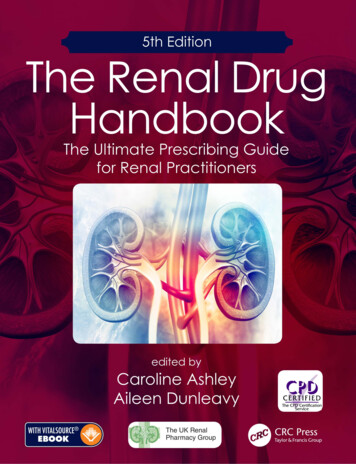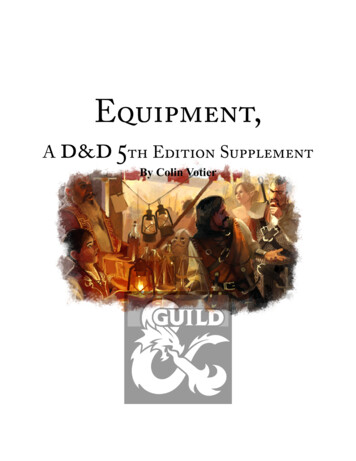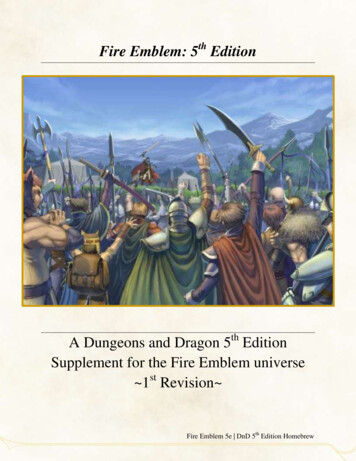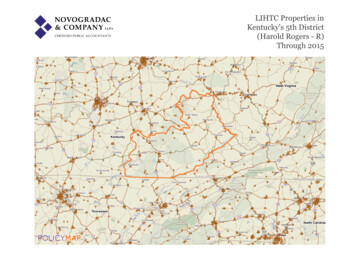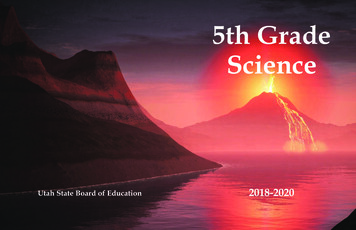
Transcription
5th GradeScienceUtah State Board of Education2018-2020
5th GradeUtah Science StandardsUtah State Board of Education2018-20201
To access a customizable version of this book, as well as other interactivecontent, visit www.ck12.orgCK-12 Foundation is a non-profit organization with a mission to reduce the costof textbook materials for the K-12 market both in the U.S. and worldwide. Usingan open-source, collaborative, and web-based compilation model, CK-12pioneers and promotes the creation and distribution of high-quality, adaptiveonline textbooks that can be mixed, modified and printed (i.e., the FlexBook textbooks).Copyright 2018 CK-12 Foundation, www.ck12.orgThe names “CK-12” and “CK12” and associated logos and the terms“FlexBook ” and “FlexBook Platform ” (collectively “CK-12 Marks”) aretrademarks and service marks of CK-12 Foundation and are protected byfederal, state, and international laws.Any form of reproduction of this book in any format or medium, in whole or insections must include the referral attribution linkhttp://www.ck12.org/saythanks(placed in a visible location) in addition to the following terms.Except as otherwise noted, all CK-12 Content (including CK-12 CurriculumMaterial) is made available to Users in accordance with the Creative CommonsAttribution-Noncommercial 3.0 Unported (CC BY-NC 3.0) License(http://creativecommons.org/ licenses/by-nc/3.0/), as amended and updatedby Creative Commons from time to time (the “CC License”), which isincorporated herein by this reference.Complete terms can be found at http://www.ck12.org/about/ terms-of-use.Printed: May, 2018For online attribution CK-12 FoundationLicensed under Terms of Use Attribution2AUTHORUSBE OER
Using this BookCREDITS AND COPYRIGHTSTUDENTS AS SCIENTISTSSCIENCE AND ENGINEERING PRACTICESCROSS CUTTING CONCEPTSNOTE TO TEACHERS3
Credits and CopyrightCredits Copyright, Utah State Board of Education, 2018.Unless otherwise noted, the contents of this book are licensed under the Creative CommonsAttribution NonCommercial ShareAlike license. Detailed information about the license is availableonline at egalcode Unless specifically notes,photographs in this book are from cK-12 or www.pixabay.comPrior to making this book publicly available, we have reviewed its contents extensively to determinethe correct ownership of the material and obtain the appropriate licenses to make the materialavailable. We will promptly remove any material that is determined to be infringing on the rights ofothers. If you believe that a portion of this book infringes another’s copyright, contact Ricky Scott atthe Utah State Board of Education: richard.scott@schools.utah.gov .If you do not include an electronic signature with your claim, you may be asked to send or fax afollow-up copy with a signature. To file the notification, you must be either the copyright owner ofthe work or an individual authorized to act on behalf of the copyright owner. Your notification mustinclude: Identification of the copyrighted work, or, in the case of multiple works at the same location, arepresentative list of such works at that site. Identification of the material that is claimed to be infringing or to be the subject of infringingactivity. You must include sufficient information, such as a specific page number or other specificidentification, for us to locate the material. Information for us to be able to contact the claimant (e.g., email address, phone number). A statement that the claimant believes that the use of the material has not been authorized by thecopyright owner or an authorized agent. A statement that the information in the notification is accurate and that the claimant is, or isauthorized to act on behalf of, the copyright owner.This book is adapted primarily from the excellent materials created by the CK-12 Foundation http://ck12.org/ - which are licensed under the Creative Commons Attribution Non Commercial ShareAlike license. We express our gratitude to the CK-12 Foundation for their pioneering work onsecondary science textbooks, without which the current book would not be possible.We especially wish to thank the amazing Utah science teachers whose collaborative efforts made thebook possible. Thank you for your commitment to science education and Utah students!Students as Scientists4
Making ScienceWhat does science look and feel like?If you’re reading this book, either as a student or a teacher, you’re going to be digging into the“practice” of science. Probably, someone, somewhere, has made you think about this before, andso you’ve probably already had a chance to imagine the possibilities. Who do you picture doingscience? What do they look like? What are they doing?Often when we ask people to imagine this, they draw or describe people with lab coats, people withcrazy hair, beakers and flasks of weird looking liquids that are bubbling and frothing. Maybe there’seven an explosion. Let’s be honest: Some scientists do look like this, or they look like otherstereotypes: people readied with their pocket protectors and calculators, figuring out how to launcha rocket into orbit. Or maybe what comes to mind is a list of steps that you might have to check offfor your science fair project to be judged; or, maybe a graph or data table with lots of numberscomes to mind.So let’s start over. When you imagine graphs and tables, lab coats and calculators, is that what youlove? If this describes you, that’s great. But if it doesn’t, and that’s probably true for many of us,then go ahead and dump that image of science. It’s useless because it isn’t you. Instead, pictureyourself as a maker and doer of science. The fact is, we need scientists and citizens like you,whoever you are, because we need all of the ideas, perspectives, and creative thinkers. Thisincludes you.Scientists wander in the woods. They dig in the dirt and chip at rocks. They peer throughmicroscopes. They read. They play with tubes and pipes in the aisles of a hardware store to seewhat kinds of sounds they can make with them. They daydream and imagine. They count andmeasure and predict. They stare at the rock faces in the mountains and imagine how those cameto be. They dance. They draw and write and write and write some more.Scientists — and this includes all of us who do, use, apply, or think about science — don’t fit acertain stereotype. What really sets us apart as humans is not just that we know and do things, butthat we wonder and make sense of our world. We do this in many ways, through painting, religion,music, culture, poetry, and, most especially, science. Science isn’t just a method or a collection ofthings we know. It’s a uniquely human practice of wondering about and creating explanations forthe natural world around us. This ranges from the most fundamental building blocks of all matter tothe widest expanse of space that contains it all. If you’ve ever wondered “When did time start?”, or“What is the smallest thing?”, or even just “What is color?”, or so many other endless questionsthen you’re already thinking with a scientific mind. Of course you are; you’re human, after all.5
But here is where we really have to be clear. Science isn’t just questions and explanations. Scienceis about a sense of wondering and the sense-making itself. We have to wonder and then really diginto the details of our surroundings. We have to get our hands dirty. Here’s a good example: twoyoung scientists under the presence of the Courthouse Towers in Arches National Park. We canbe sure that they spent some amount of time in awe of the giant sandstone walls, but here in thisphoto they’re enthralled with the sand that’s just been re-washed by recent rain. There’s this giantformation of sandstone looming above these kids in the desert, and they’re happily playing in thesand. This is ridiculous. Or is it?How did that sand get there? Where did it come from? Did the sand come from the rock or doesthe rock come from sand? And how would you know? How do you tell this story?Look. There’s a puddle. How often is there a puddle in the desert? The sand is wet and fine; and itmakes swirling, layered patterns on the solid stone. There are pits and pockets in the rock, like theone that these two scientists are sitting in, and the gritty sand and the cold water accumulate there.And then you might start to wonder: Does the sand fill in the hole to form more rock, or is the holeworn away because it became sand? And then you might wonder more about the giant formationin the background: It has the same colors as the sand, so has this been built up or is it being worndown? And if it’s being built up by sand, how does it all get put together; and if it’s being worn awaythen why does it make the patterns that we see in the rock? Why? How long? What next?Just as there is science to be found in a puddle or a pit or a simple rock formation, there’s sciencein a soap bubble, in a worm, in the spin of a dancer and in the structure of a bridge. But this thingwe call “science” is only there if you’re paying attention, asking questions, and imaginingpossibilities. You have to make the science by being the person who gathers information andevidence, who organizes and reasons with this, and who communicates it to others. Most of all, youget to wonder. Throughout all of the rest of this book and all of the rest of the science that you willever do, wonder should be at the heart of it all. Whether you’re a student or a teacher, this wonderis what will bring the sense-making of science to life and make it your own.Adam JohnstonWeber State University6
Science and Engineering PracticesScience and Engineering Practices are what scientists do to investigate and explore naturalphenomena.7
Cross Cutting ConceptsCrosscutting Concepts are the tools that scientists use to make sense of naturalphenomena.8
A Note to TeachersThis Open Educational Resource (OER) textbook has been written specifically for students as areputable source for them to obtain information aligned to the 3rd Grade Science Standards. Thehope is that as teachers use this resource with their students, they keep a record of theirsuggestions on how to improve the book. Every year, the book will be revised using teacherfeedback and with new objectives to improve the book.If there is feedback you would like to provide to support future writing teams please use the followingonline survey:http://go.uen.org/b629
Table of ContentsCHAPTER 1 . 111.1 Changes in matter . 131.2 Physical Changes . 201.3 Chemical Changes . 281.4 Summary Section . 34CHAPTER 2 . 372.1 Weathering and Erosion . 392.2 Earthquakes and Volcanoes . 512.3 Deposition . 572.4 Summary Section . 61CHAPTER 3 . 633.1 Magnetism . 653.2 Earth’s Magnetic Fields . 723.3 Summary Section . 77CHAPTER 4 . 814.1 Electricity . 834.2 Electrical Circuits . 894.3 Summary Section . 95CHAPTER 5 . 995.1 Heredity . 1015.2 Adaptations . 1155.3 Summary Section . 12210
CHAPTER1Standard 1: Physical and ChemicalChangesChapter Outline1.1 CHANGES IN MATTER1.2 EVIDENCE OF PHYSICAL CHANGE1.3 EVIDENCE OF CHEMICAL REACTIONS1.4 SUMMARY SECTION11
Standard 1: Students will understand that chemical and physicalchanges occur in matter.Objective 1: Describe that matter is neither created nor destroyed eventhough it may undergo change.1. Compare the total weight of an object to the weight of its individual partsafter being disassembled.2. Compare the weight of a specified quantity of matter before and after itundergoes melting or freezing.3. Investigate the results of the combined weights of a liquid and a solid afterthe solid has been dissolved and then recovered from the liquid (e.g., saltdissolved in water then water evaporated).4. Investigate chemical reactions in which the total weight of the materialsbefore and after reaction is the same (e.g., cream and vinegar before andafter mixing, borax and glue mixed to make a new substance).Objective 2: Evaluate evidence that indicates a physical change hasoccurred.1. Identify the physical properties of matter (e.g., hard, soft, solid, liquid, gas).2. Compare changes in substances that indicate a physical change hasoccurred.3. Describe the appearance of a substance before and after a physicalchange.Objective 3: Investigate evidence for changes in matter that occur during achemical reaction.1. Identify observable evidence of a chemical reaction (e.g., color change,heat or light given off, heat absorbed, gas given off).2. Explain why the measured weight of a remaining product is less than itsreactants when a gas is produced.3. Cite examples of chemical reactions in daily life.4. Compare a physical change to a chemical change.5. Hypothesize how changing one of the materials in a chemical reaction willchange the results.12
1.1 Changes in matterWhat is everything around us made of?Matter is any substance that has mass and takes upspace. Everything you can see and touch is made of matter,including you! There is even some matter you cannot see, likeair. Matter cannot be created or destroyed, but matter canundergo changes.States of MatterWhat is a solid?A solid is anythingthatholdsitsshape. A solid cannotbe a liquid or a gas.These tables andchairsaresolidobjects. The floorunder the tables andchairs is a solid. Theglass windows in thebackground are alsosolids.https://flic.kr/p/amFB2D13
What is a liquid?https://flic.kr/p/UWVEZkA liquid is anything that can fill the shape of its container. As youcan see in this image the water curves with the sides of theglass. Water, milk, and blood are all examples of liquids.What is a gas?Gas, matter that takes the volume and shape of a container, isall around us. It is the air we breathe, the steam coming off of aboiling pot, and smoke from a fire.Oxygen is a gas that humans need tobreathe and live. Trees use carbondioxide, another common gas. Gases arenecessary for many living things tosurvive.Video on gases: http://go.uen.org/b4C14
Look at the following pictures of where a gas is being used.Has your bike ever gotten a flat?You can use a bike pump to pushgas into your tire to air it back up.Balloons are filled withhelium gas. You cannot seethe gas, but it is there as theballoons are blown up andfloating.A scuba diver has anoxygen tank on his back tobreathe underwater.Visitthefollowingsimulation to exploremore about states ofmatter:http://go.uen.org/b4D15
Using Properties to Describe MatterWeight is the measurement of how heavy something is basedon the force of gravity. We can use a scale to measure weight.You are most familiar with pounds when you weigh items. Inscience, a unit we can use to measure weight is grams orkilograms. For example, if you weigh 80 pounds, we could alsosay you weigh 36 kilograms.A giant candy bar weighs 200 grams. If you cut the candy bar inhalf, how much would each half weigh? Each half would weigh100 grams. What do you think would happen if you melted thechocolate bar? What would it weigh then? Because matter isnot created or destroyed, it will still weigh 200 grams even thoughthe solid candy bar is now a liquid. The candy bar has justundergone a physical change, a change in state from a solid toa liquid.Guess how much a 500 gram bottle of root beer weighs if youfreeze it in a freezer? You are right again. It is going to weigh500 grams because it is still the same matter. Freezing or meltingdoes not change the amount of weight in a substance, this is alsoa physical change, from a liquid to a solid.Pretend that you ordered a bike online and it gets delivered inthree different boxes. The bike pieces in each box weigh 2000grams (or about 5pounds). If youstack all of thepieces on scale,how much will theyweigh? If you said6000 grams you areright. Now put thebike together andput it on the scale.What will the bikeweigh?16
Have you ever made Kool-Aid? To make it, you add water, sugarand the Kool-Aid into a container and mix it together. Doesmixing different types of matter change the weight?What will the total weight of Kool-Aid mixture be after mixingthem together? 2 gallons of water weighs about 8000 grams. 1 cup of sugar weighs 200 grams 1 Kool-Aid weighs 5 gramsThe total weight after mixing them together is 8205 grams.When you make Kool-Aid, the sugar and Kool-Aid dissolve inthe water when it is mixed. When something dissolves in water,it breaks apart into tiny pieces that are too small to see. If youcould shrink down super tiny and jump into a cup of Kool-Aid,you would see that the sugar is still sugar and the Kool-Aid is stillKool-Aid. They are just really tiny because they dissolved inwater. When substances are mixed together, their individualweights do not change. This is another example of a physicalchange.17
Chemical ReactionsSometimes when you mix substances together, they react witheach other and actually form new substances. This is called achemical reaction. Even during chemical reactions, the weight ofthe substances will not change. Have you ever made slime? Tomake slime, you mix borax (a type of laundry detergent), whiteglue, and water together. These substances experience areaction and slime is formed. Even though slime is totallydifferent from borax, glue and water, it will weigh the sameamount.Example:1 cup of white glue 250 grams1 cup of water 236 grams2 teaspoons of borax 10 gramsAfter you mix the 3 ingredients together how much will the slimeweigh?18
In Review:Matter is all around you. Even though matter might look differentwhen it is melted or frozen, when it is mixed together, or when achemical change occurs, matter is not created or destroyed. It isstill the same matter and will still have some of the sameproperties, like weight.Think like a scientist1. What is everything made of?2. What are some properties we can use to describe matter?3. What are the similarities and differences of solids, liquids,and gases?4. Explain why a melted ice cube weighs the same as a solidice cube.Please visit the following websites to explore more of the basicsof 9
1.2 Physical ChangesIs it possible for a substance to be changed,but still remain the same substance?You hit a baseball out of the park and head for first base. You’reexcited. The score is tied, and now your team has a chance ofgetting a winning home run. Then, you hear a crash. Oh no! Thebaseball hit a window in a neighboring house. The glass has abig hole in it, surrounded by a web of cracks. The glass haschanged. It’s been broken into jagged pieces. But the glass isstill glass. Breaking the window is an example of a physicalchange in matter.When glass breaks, its physical properties change. Instead ofone solid sheet of glass, it now has many pieces.A physical change in matter is a change in physical state. Glassbreaking is just one example of a physical change. In eachexample, matter may look different after the change occurs, butit’s still the same substance.20
The shape of an ice cube changes as it melts and becomes aliquid. However, the matter does not change. It is stillwater. Melting is an example of a change of state. The meltedice cube may be refrozen, so melting is a reversible physicalchange. Physical changes that involve a change of state cansometimes be reversible. Other changes of state includeevaporation (liquid to gas), freezing (liquid to solid), andcondensation (gas to liquid).Let’s read a story to try to understand this a bit more.The Story of StevenSteven is a boy in first grade at a school in a small village, whichgets very hot in summer. He loves to play soccer. After schoolhe often goes over to soccer field to play a game with his friends.They really like having Steven play with them. Even though he isa few years younger, he is very talented and also fun and caring.Steven especially likes Joe and they play well together as ateam.One day after school, Steven thought he would do somethingnice for his friends, and surprise them with popsicles after theywere finished playing. Steven bought 5 ice popsicles, one for21
himself and one for each of the other kids. He put the popsiclesin a bowl and placed some ice blocks around them to keep themcool. Steven then ran off to join the others playing soccer.After the game, Steven ran back to the bowl to get the popsicles.But he got such a shock when he got there. They were all gone!He was so upset and started to cry. The other kids saw thatSteven was upset and ran over to see what was wrong.“Hey Steven, what’s wrong? Did you hurt yourself while playing?”Joe asked.“No, I didn’t. I bought some popsicles for all of you as a surpriseand when I came back to get them, they were all gone! I thinksomeone stole and ate them and just left the sticks! Look!”Steven cried out.“Oh no, don’t cry Steven! It’s not your fault, and no one stole themor ate them either,” Zach said while patting Steven on the back.“Yes, Steven, actually we learned in class today about whathappened to your popsicles,” said Sophie, “and I can explain itto you too. Do you see that your bowl is actually not empty?There is a liquid in it. And it also has a red color, which was thecolor of your popsicles.”“Yes, I see that,” answered Steven, “but then how did thathappen?”Tom then answered, “Your popsicles melted from the heat in theair around us. Even if the sun was not so hot, they would havemelted! For something to stay frozen it needs to be at a very coldtemperature, like in a freezer.”22
“Yes, melting is when heat causes the solid popsicles to changeinto a liquid,” Sophie replied, “So no one stole the popsicles, theyjust melted.”“Oh ok, I see,” said Steven, “I must be really silly not to knowthat!”“No, not at all Steven! We only learned about it today in class!”laughed Zach.“I know what we should do!” shouted Joe, “Let’s go to the storenow. I have some extra change and we can buy some morefrozen popsicles!”They all really liked this idea, especially Steven, who was nowlaughing. So off they all went, the kids and Steven, and boughtsome more popsicles and sat under the tree to eat them.Heating and cooling can cause a change of state23
We have seen that melted solids can be solidified again. Theprocess can be reversed, or turned around, by adding orremoving heat.Let’s review what we have learned from Steven’s story.Here is a summary of the different state changes:Change ofstateHeating orcooling?We call theprocessSolid to a liquidHeatingMeltingLiquid to a gasHeatingEvaporatingGas to a liquidCoolingCondensingLiquid to a solidCoolingFreezing orsolidifyingThe science of chocolate. http://go.uen.org/b4GDissolvingDissolving – combining matter with a liquid into a solution-is alsoa reversible physical change. When 3 grams of salt are dissolvedin 5 grams of water, the salt is in a solution. The solution willweigh 8 grams, the total weight of the salt and water. The saltand water can be separated again when the water evaporates.After the water evaporates, the salt left behind will still weigh 3grams.Because the type of matter remains the same with physicalchanges, the changes are often easy to undo. For example,braided hair can be unbraided. Melted chocolate can be put in afridge to harden to a solid. Dissolving sugar in water is also aphysical change. How do you think you could undo it?24
These stunningrock arches inUtahwerecarved by windblownsand.Repeatedbeating by thesand wore awaythe rock, bit bybit,likesandpaperonwood. The bits ofrock worn away by the sand still contain the same minerals ormatter as they did when they were part of the large rock. Onlythe size and shape of the rock have changed, from a single largerock to millions of tiny bits of rock. Changes in size and shapeare physical changes in matter.You can learn more about physical changes and why they occurby watching this video at http://go.uen.org/b4I and this videohttp://go.uen.org/b4JWant to buy a car – cheap? Notice there is no specification suchas “in good condition” or “needs a little work”. The car in the photois beat up. The body is damaged and the windows are broken.25
But this is still a car. It has the components of a car, even thoughyou may not want to buy it in its present condition. You couldchange that condition by fixing the dents, repainting the car andreplacing the broken windows. With those changes, you mighthave a car worth driving.But not all physical changes can be reversed. When a piece ofwood is ground into sawdust, the change is irreversible since thesawdust cannot be changed into the same piece of wood that itwas before. Cutting the grass or pulverizing a rock are otherirreversible physical changes. Even though these physicalchanges cannot be reversed, they are still physical changesbecause the matter hasn’t changed into a new substance.Q: Can you identify the physical changes in the diagram below?A: The paper is being cut into smaller pieces, which is changingits size and shape. The ice cubes are turning into a puddle ofliquid water because they are melting. The tablet is disappearingin the glass of water because it is dissolving into particles thatare too small to see. The lighthouse is becoming coated with iceas ocean spray freezes on its surface. These are examples ofmatter undergoing a change of state.26
Think like a Scientist1. Is it possible to change something and have it still be made ofthe same “stuff” it was made of before?What do you call this change?Is it possible to have the same material as a solid, liquid andgas?2. How can water be a solid, liquid and gas?3. What does it mean when we say that matter is changingstate?How do you know when an object has changed state?4. Give an example of a physical change that is not reversible.27
1.3 Chemical ChangesCommunities often use fireworks to celebrateimportant occasions. Fireworks createawesome sights and sounds!Do you know what causes the brilliant lights and loud booms ofa fireworks display?The answer: chemical changes.A chemical change occurs whenever matter changes into abrand new substance with different kinds properties. A chemicalchange is also called a chemical reaction.Many complex chemical changes occur to produce theexplosions of fireworks.An example of a simpler chemical change is the burning ofmethane. Methane is the main component of natural gas, whichis burned in many home furnaces. During burning, methanecombines with oxygen in the air and changes into the gasescarbon dioxide and water vapor.28
Did you ever make a “volcano” using baking soda and vinegar?What happens when you combine baking soda and vinegar?They produce an eruption of foamy bubbles. This happensbecause a chemical change occurred. When vinegar and bakingsoda combine, they form carbon dioxide, a gas that causes thebubbles. It’s the same gas that gives soft drinks their fizz. Thematerials that combine together in a chemical change are calledreactants. The new substances that are made arecalled products.This girl is pouring vinegar on baking soda. This causes abubbling “volcano”. Not all chemical changes are as dramatic asthis “volcano”. Some are slower and less obvious.These chemical changes all result in the formation of newsubstances with different chemical properties. Do you think anyof these changes could be reversed?29
Identifying Chemical ChangeMost chemical changes are not as dramatic as explodingfireworks, so how can you tell whether a chemical change hasoccurred? There are clues. You just need to know what to lookfor.A chemical change has probably occurred if bubbles arereleased, there is an unexpected change of color, or an odor isproduced. Other clues include the release of heat or loud noises.Examples of chemical changes that produce these reactions areshown in the figure below.30
Evidence of Chemical Change Gas bubbles released (not by evaporation)An unexpected color change occursAn unexpected odor is producedA new substance is madeAn unexpected change of temperatureAn unexpected noise is given offAn example of matter changing color is a penny changing fromreddish brown to greenish brown as it becomes tarnished. Thecolor change indicates that a new chemical substance has beenproduced. Copper on the surface of the penny has combined withoxygen in the air to produce a different substance called copperoxide.Food spoiling is a change that produces an odor. What type ofchemical change do you think is happening?When wood burns, it produces a smoky odor. Burning is achemical change.Fire
possibilities. You have to make the science by being the person who gathers information and evidence, who organizes and reasons with this, and who communicates it to others. Most of all, you get to wonder. Throughout all of the rest of this book and all of the rest of the science that y
